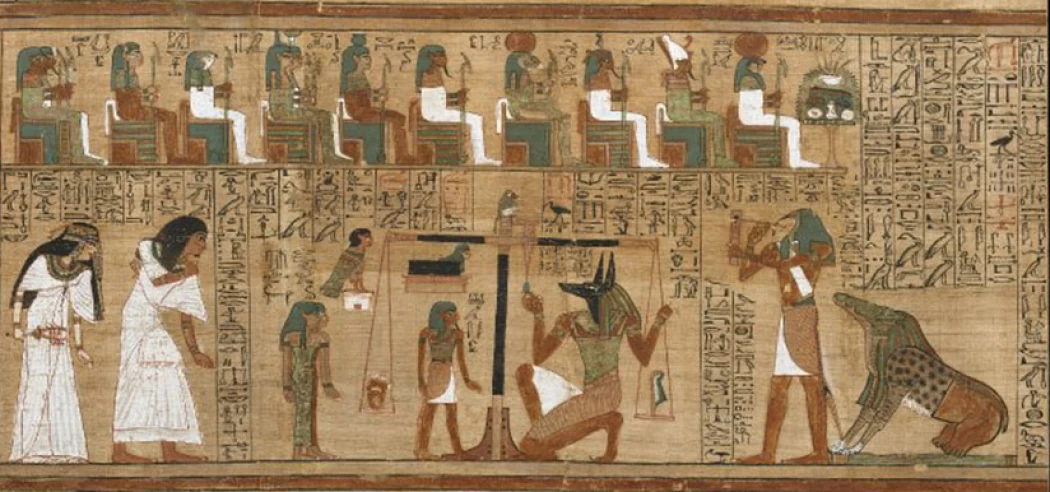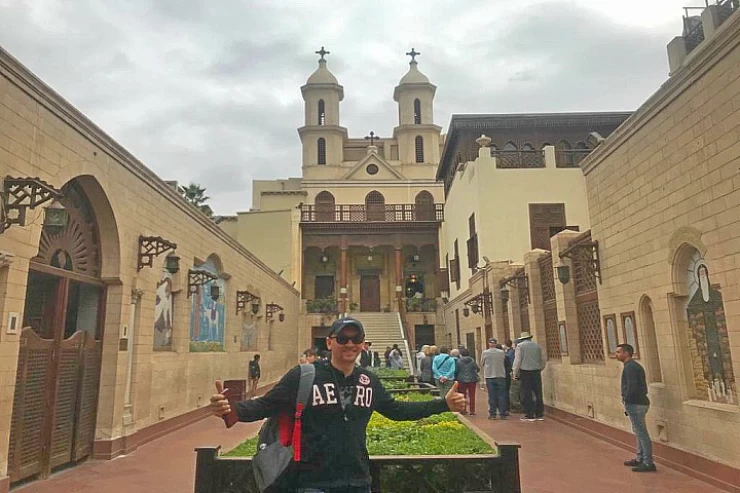
埃及的宗教
埃及的宗教:塑造千年历史的信仰挂毯
如果说埃及经常被历史学家称为"文明的摇篮",那么它可能是整个人类历史上最复杂的宗教方面之一。 尼罗河肥沃的河岸确实承载了农业,但它们也产生了广阔的文化,宗教渗透到日常生活,政治和社会秩序的每一个方面。 从古埃及文明的早期到今天,尽管埃及主要是一个沙漠干燥的土地,但埃及一直是不同宗教的大熔炉,从一夫多妻制开始到最终拥抱一神教。
在这篇文章中,第二节,我们是怎样的:对埃及历史的反思,从古代多神教到基督教和伊斯兰教,将被回顾和分析,以及宗教在埃及人民生活中的作用。
1. 古埃及宗教:多神教和众神万神殿
作为一个社会,可以说宗教是古埃及的基础。 古埃及人崇拜,因为他们知道,从尼罗河的年度洪水到生命和死亡的循环,一切都不仅是自然的,而且是由一些神圣的力量控制的。 这是一种信仰,其特点是神的多样性,所有人都负责存在和/或性质的特定方面。
主要的神和女神
Ra(或Re):被尊为太阳神,Ra被描绘成古埃及宗教中最有力的神。 人们认为Ra白天居住在天空,为地球提供光线,晚上居住在冥界。 他经常被描绘成一个猎鹰的头,并在他的头顶上戴一个太阳盘。
奥西里斯:奥西里斯是埃及的死亡和复活之神,在埃及神话中占有重要地位,将生命的概念表示为出生,死亡和复活的循环。 奥西里斯神话和他的复活,在他的妻子伊希斯有能力的手中,成为埃及来世经历的支柱。
女神是非常受欢迎和强大的。 她是母亲、魔法和生育的保护者. 她的保护方面和使奥西里斯起死回生的能力使她受到崇拜。
荷鲁斯,天空之神和国王的神,经常被显示为鹰。 他也是因为他与神为统治埃及地而设的混乱的竞争而闻名的,埃及地代表了秩序和混乱的斗争。
阿努比斯是埃及的神,与丧葬仪式和保护死者有关。 他的重要任务是监督心脏称重的仪式,评估一个人在下一个世界的精神。
神不是遥远的或抽象的人物;他们存在于生活的各个方面。 埃及人在全国各地建造寺庙,进行精心制作的仪式,并提供每日祈祷和牺牲,以确保神灵的青睐并保持ma'at—和谐与秩序。
寺庙和牧师:神圣和凡人之间的桥梁
崇拜不是建造寺庙的唯一原因;这些建筑被认为是神灵的尘世家园。 法老有巨大的寺庙,如卡纳克和卢克索建造崇拜和执行仪式的神,以及展示他们统治土地的力量。 除了祭司之外,没有人被允许进入寺庙最神圣的最深处,他们被认为是唯一能够与众神互动的人。
祭司每天向神提供食物、熏香和祈祷,履行他们的职责,确保神在埃及土地上持续提供安全。 这些神职人员是非常强大的,有时甚至有政治权威,因为他们帮助法老在宗教事务。
2. 来世:永恒重要的旅程
对于古人来说,死亡不是永久的结局;死后会有生命。 这个概念推动了人们关注死亡的努力,并思考他们将如何以适当的方式为他们的黑社会之旅做好准备,在他们看来,黑社会并不是一个容易到达的地方,但只要克服挑战,就能保证永恒的幸福。
木乃伊和身体的保存
木乃伊在塑造埃及人对死亡时发生的事情的看法方面起着关键作用。 身体被维护,以便'ka'(或灵魂)会记住并在死后回到它的住所。 木乃伊是通过一套程序来实践的,包括器官采购艺术,化学处理和整个身体的亚麻包裹。
为来世做准备的过程还包括制作坟墓,墓葬中会有死者需要的物品,如食物、衣服和用来描绘仆人的直立的"ushabti"人物。 皇家墓地,如吉萨金字塔和国王谷展示的壮丽,表明采取了极端措施,以确保领导人死亡时有足够的休息和医疗保健。
木乃伊的习俗与埃及人民对来世的热爱息息相关。 尸体必须以允许精神或"ka"识别它并能够在死后返回的方式进行维护。 木乃伊出现在具体的实践中,其中包括器官缩小,物质干燥和用绷带涂抹身体的艺术。
为永恒做准备的另一个方面是建造包含死者必需品的坟墓,例如丰富的食物和衣服以及被称为ushabtis的仆人的微型雕像。 这样的崇拜可以从皇家墓地的奇妙建筑中看出来,例如围绕吉萨大金字塔和国王谷的那些墓地,在那里,领导人在死亡期间合理休息的无限希望。
心仪式的称重
"心的重量"仪式是关于来世的关键信念之一。 在埃及宇宙学中,当一个死去的人被带到死亡之地时,神阿努比斯的任务是用代表真理和正义的神马阿特的羽毛来衡量心脏。 在鳞片倾斜于羽毛的地方,个体被认为适合在另一个世界的死者中占据一席之地。 如果心脏把鳞片放在羽毛上,那么由于某种不礼貌的行为或谎言,那颗心脏将被凶猛的女神阿米特消耗,本质将不复存在。
3. 一神论的引入:阿玛纳时期
在法老Akhenaten统治期间,也被称为Amenhotep IV,这是公元前1353年至1336年之间,见证了许多变化,特别是在埃及的宗教习俗中。 阿肯那顿相信只有一个神可以崇拜,那就是太阳盘阿滕,他提倡只崇拜阿滕。 他建造了一座名为Akhetaten(amarna,现代)的新城市,并专注于对这一位神的崇拜,完全排除了埃及万神殿中其余的传统神灵。
这种宗教习俗的极端变化持续了多长时间。 在阿肯那顿死后,跟随他的政府,特别是通过图坦卡蒙国王,恢复了以前对许多神的崇拜,阿滕的崇拜在很大程度上被从历史中抹去。 尽管如此,阿肯那顿关于宗教的强迫倾向问题仍然是古埃及宗教故事中一个奇怪的一页。 它表明,即使在一个僵化的制度到位的情况下,宗教的潜在变化也是如此的威胁。
4. 基督教在埃及的兴起
众所周知,基督教的传播在公元前30年罗马人征服埃及的某个时候生根发芽。公元后,基督教的广泛聚居地在几个地区开始,特别是亚历山大,在那里它成为建立基督教事务教育和教会正统的中心。 因此,圣马克在亚历山大市的到来被视为科普特教堂成立的日期,科普特教堂通常被认为是最古老的教堂之一。
然而,基督教所宣扬的意识形态在最严重的迫害浪潮中被大多数人所接受,这在罗马国王时期更为明显。 然而,在君士坦丁皇帝统治的公元4世纪,基督教成为最常用的宗教,它在整个帝国中得到了充分和正式的接受。
虽然科普特教会仍然在亚历山大的宗主教之下,但它也能够培养一些自己的当地传统,语言(科普特语,古埃及语言的衍生物)和艺术风格。 科普特基督教一直是,并且仍然是埃及宗教构成的重要组成部分,大多数科普特人是东正教徒,他们构成了现代埃及人口的一大部分。
5. 埃及的伊斯兰教:新时代的曙光
在7世纪,埃及的宗教又发生了一次巨大的变化--伊斯兰教的到来。 公元641年,阿拉伯将军Amr ibn Al-As入侵埃及,几个世纪以来,伊斯兰教成为该国的主要宗教,导致当地习俗甚至基督教的消失。
随着伊斯兰统治的引入,埃及的历史见证了文化和智力活动的高度,特别是在法蒂玛和马穆鲁克王朝期间。 公元969年,法蒂玛人建立了一座后来被称为开罗的城市,因为它有许多清真寺,其中包括al Azhar,这是伊斯兰教育最古老的地方之一,至今仍是一所神圣的伊斯兰大学。
目前,伊斯兰教仍然是埃及最大的宗教,其大部分人口是逊尼派穆斯林。 然而,尽管如此,埃及仍然有大量的基督徒,主要是科普特人,他们在整个埃及宗教历史中表现出内部和解的各个民族。
6. 埃及的现代宗教生活
宗教仍然是普通埃及公民日常生活的核心部分。 穆斯林呼吁祈祷,称为"adhan",每天可以从清真寺听到五次,每个都提醒穆斯林不要做他们正在做的事情并祈祷。 斋月,开斋节和宰牲节等传统以特别的盛况和辉煌庆祝,涉及家庭成员甚至亲属。
基督教历法的节日,例如圣诞节(1月7日)和复活节(日期不同),也积极庆祝教堂服务和街头庆祝活动。 尽管如此,在某些情况下,宗教团体之间存在某种程度的敌意。 埃及粗糙而分散的历史使该国有可能因其不同信仰和教派的和平存在而受到赞赏。
结论
埃及的宗教历史显示了几千年来的急剧转变,从古埃及人的多神教到基督教的诞生以及随后整个国家皈依伊斯兰教。 从卢克索和卡纳克的伟大寺庙到开罗的高尖塔,这些时期都有主导埃及文化,社会和建筑的元素。
埃及宗教的叙述是对信仰的持久性以及一个民族在精神面貌的巨大动荡中适应和繁荣的庆祝。 直到今天,埃及仍然是新旧和谐共存的地方,尽管在实践和信仰上发生了冲突,在那里这些实践被数百万人所接受。
If Egypt has often been referenced by historians as ‘the Cradle of Civilization’, it has probably one of the most complicated religious aspects in entire human history. The fertile banks of the Nile did host agriculture, but they also produced a vast culture, where religion permeated every single aspect of everyday life, politics, and social order. From the earliest days of ancient Egyptian civilization up to this day, despite being primarily a desert dry land, Egypt has been a melting pot of different religions, starting from polygamy to finally embracing monotheism.
In this piece, Section II, How We Were: Reflections on Egyptian History, From Ancient Polytheism to Christianity & Islam, will be reviewed and analyzed, as well as the role of religion in the lives of the Egyptian population.
As a society, it can be said that religion was the foundation of ancient Egypt. The ancient Egyptians worshiped as they knew that everything from the annual flooding of the Nile to the cycle of life and death was not only natural but controlled by some divine power. This was a belief characterized by a multiplicity of deities, all of whom were in charge of a specific facet of existence and/or nature.
The Major Gods and Goddesses
Ra (or Re): Revered as the God of the Sun, Ra has been depicted as the most potent deity in ancient Egyptian religion. It was believed that Ra inhabited the sky during the day, providing light to the earth, and resided in the underworld at night. He would oftentimes be portrayed with a falcon’s head and wear a sun disk on top of his head.
Osiris: Osiris was an Egyptian death and resurrection god and held a significant place in Egyptian mythology in representing the concept of life as a cycle of birth, death, and resurrection. The Osiris myth and his resurrection, in the capable hands of Isis, his wife, became the pillars of the Egyptian afterlife experience.
The goddess was immensely popular and powerful. She was a protector of motherhood, magic, and fertility. Her protective aspect and the ability to bring Osiris back to life made her worshiped.
Horus, the god of the sky and of the king, is often shown as a hawk. He was also known because of his rivalry with the chaos god Set for dominion over the land of Egypt, which represents the struggle of order and chaos.
Anubis is the Egyptian god associated with funerary rites and the protection of the dead. He had the important task of supervising the ceremony of the heart's weighing, which assessed a person’s spirit in the next world.
The gods were not distant or abstract figures; they were present in every facet of life. Egyptians built temples across the country, conducted elaborate rituals, and offered daily prayers and sacrifices to ensure the favor of the gods and maintain ma’at—harmony and order.
Worship wasn’t the only reason for building temples; these structures were believed to be the earthly homes of the gods. The pharaohs had enormous temples like Karnak and Luxor built to worship and carry out rituals for the gods as well as to showcase the power of their rule over the land. No one was permitted to enter the temple’s most sacred, innermost areas except for the priests, who were thought to be the only ones capable of interacting with the gods.
Priests offered meals, incense, and prayers to the gods on a daily basis, performing their duties towards ensuring the gods’ continuous provision of security over the land of Egypt. These clergymen were very powerful and at times even had political authority as they helped the pharaohs in religious affairs.
For the Ancients, death was not a permanent end; there would be life after death. This notion fueled the people’s efforts to focus on death and think about how they would prepare in the appropriate way for their journey to the underworld, which in their minds was not an easy place to reach but one that guaranteed everlasting bliss as long as the challenges were overcome.
Mummification and the Preservation of the Body
Mummification was pivotal in shaping the Egyptian view of what happens when one dies. The body was to be maintained so that the ‘ka’ (or soul) would remember and go back to its residence after death. Mummification came to be practiced with a set of procedures that included arts of organ procurement, chemical treatment, and linen envelopment of the entire body.
A process of putting up preparatory arrangements for one’s afterlife would also include making tombs, which would have items that the dead person would require, such as food, clothes, and upright ‘ushabti’ figures meant to depict servants. The magnificence that royal burial places such as the Giza pyramids and those in the Valley of the Kings display indicates the extreme measures taken to ensure adequate rest and healthcare for the leaders when they die.
The mummification custom was bound to the Egyptian people's love of the afterlife. Bodies had to be maintained in a way that allowed the spirit, or 'ka', to identify it and be able to go back in after death. Mummification came to be seen with specific practices, which included the arts of organ downsizing, substance drying, and body plastering with bandages.
Another aspect of preparing for eternity was that of constructing tombs containing the essentials for the deceased, such as an abundance of food and clothes and miniature statues of servants known as ushabtis. Such an adulation can be seen from the wonderful construction of royal burial sites such as those surrounding the Great Pyramids of Giza and along the Valley of the Kings, where endless hope lies for the reasonable resting of the leaders within the period of their deaths.
The “weighing of the heart” ritual is one of the key convictions regarding the hereafter. In Egyptian cosmology, when a deceased individual was brought to the land of the dead, the god Anubis was tasked with weighing the heart against the feather of Ma’at, the deity representing truth and justice. Where the scales tipped in favor of the feather, the individual was considered fit to take his place among the dead in the other world. If the heart tipped the scale against the feather, then due to some impertinent act or lie, that heart would be consumed by the ferocious goddess Amit and the essence would no longer exist.
3. The Introduction of Monotheism: The Amarna Period
Throughout the reign of Pharaoh Akhenaten, also known as Amenhotep IV, which was between the years 1353 and 1336 BCE, many changes were witnessed, especially in Egyptian religious practices. Akhenaten believed there was only one God to worship, and that was Aten, the sun disk, and he promoted the worship of Aten only. He constructed a new city called Akhetaten (Amarna, modern) and concentrated on the worship of this one god, excluding completely the rest of the traditional deities in the Egyptian pantheon.
The extent of how long this extreme change in religious practices lasted is very minimal. After the death of Akhenaten, the former worship of many gods was reinstated by the administrations that followed him, particularly through King Tutankhamun, and the cult of Aten was, for the most part, expunged from history. Still, the issue of Akhenaten's obsessive tendencies concerning religion remains a curious page in the story of religions in ancient Egypt. It demonstrates how potential changes in religion can be such a threat even when a rigid system is in place.















